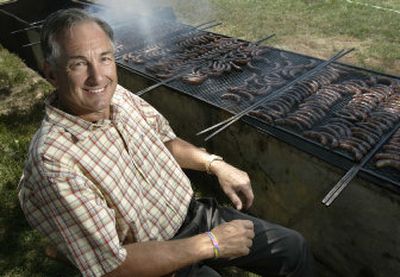Building a better brat

JOHNSONVILLE, Wis. – Johnsonville Sausage Co. CEO Ralph Stayer gets a real bang out of making bratwurst better.
Last month, following tradition, he lit a firecracker in his office waste basket to celebrate a change to his company’s “Heat & Serve” precooked sausage that made it taste as good as a fresh-grilled brat.
“I’ve gone through quite a few waste baskets,” said Stayer, 62. “We celebrate innovation here.”
With this year’s barbecue season sizzling and the Atkins diet on the ropes, Stayer lit into how the company his father began on Oct. 1, 1945, helped turn the bratwurst from a little-known spiced pork sausage into the nation’s “fastest-growing protein” among grillers.
“There’s a thousand little things that go into making a great-tasting sausage,” Stayer said. “It’s just attention to detail, every darn one.”
Like other regional flavors that have spread across the country, such as Chicago-style pizza and Tex-Mex cuisine, the bratwurst’s popularity has become a source of local pride in Wisconsin – alongside beer, cheese and Green Bay Packers football.
“We introduced bratwurst to America,” said Johnsonville group vice president David Finch.
But Johnsonville, unlike other food makers that sold out to conglomerates – despite a brief minority ownership by Sara Lee Corp. – has stayed owned by the family that founded it.
Last year, led by bratwurst sales, Johnsonville became the nation’s largest sausage brand by revenue, and its brats are now sold seasonally at some 4,000 McDonald’s nationwide, in 16 NFL football stadiums and in stores in 38 countries outside the United States.
Johnsonville claims brats’ popularity among U.S. grillers grew faster than other sausages, pork, fish and hot dogs in the four years through 2003 while steak, chicken and hamburgers shrank. According to ACNielsen, prepackaged and measured bratwurst accounted for about $260 million in domestic annual sales until mid-July. That’s up 31 percent from four years ago, compared to 10 percent growth for all packaged meats.
Johnsonville total sales this year through May grew 19 percent to $440 million, making it bigger than Sara Lee’s Hillshire Farms at $369 million. Johnsonville claims about 60 percent of its sales come from brats.
“They’re a smaller company playing against a bunch of giant companies and they’re winning,” said food industry consultant Mark Boyer of perishables consulting group, PMG. “If you think of the meat department, you have the Tysons of the world, the Hormels of the world … Johnsonville is not only competing but winning in that space.”
Boyer said the company has succeeded in using its three “Big Taste Grill” semitrailers equipped with massive grills to get people to try the product. At a recent visit to a retailer, he saw the truck out back as its handlers grilled lunch for the retailer’s employees. The giant grill also makes a free-of-charge cameo appearance in the new “The Dukes of Hazzard” movie.
“It’s guerrilla marketing,” Boyer said. “It helps people get behind the product. They’re masterful at it.”
In its ads, the company fills in the gaps for people who don’t know what a brat is, Finch said. Don’t poke it, or the juices will spill out, one warns. Another says a “brat hot tub” of beer, butter and onions is a good way to keep the product warm.
And by the way, it’s br-AHT, like the past tense of bring, not brat, like the pest.
ABC football analyst John Madden often mentions brats when covering Packers games, and displaced Wisconsinites, who once packed suitcases with frozen sausages from home, have also acted as brat ambassadors at cookouts across the country.
“I haven’t served one yet that people didn’t like,” said Patrick Neal, a 29-year-old Wall Street options trader from Fond du Lac, Wis., who serves Johnsonville brats to friends at football outings. “It’s my way of rubbing in my Packers spirit.”
And despite the barrage of diets and an ingredient list that shows three-quarters of a brat’s calories come from fat, Johnsonville has continued to grow. Last year, sales surged about 25 percent.
“I think with all the diets out there, people are really confused and they’re throwing up their arms and saying, ‘Well, let’s just go for it,’ ” said Marianne Turow, an associate professor of nutrition at the Culinary Institute of America.